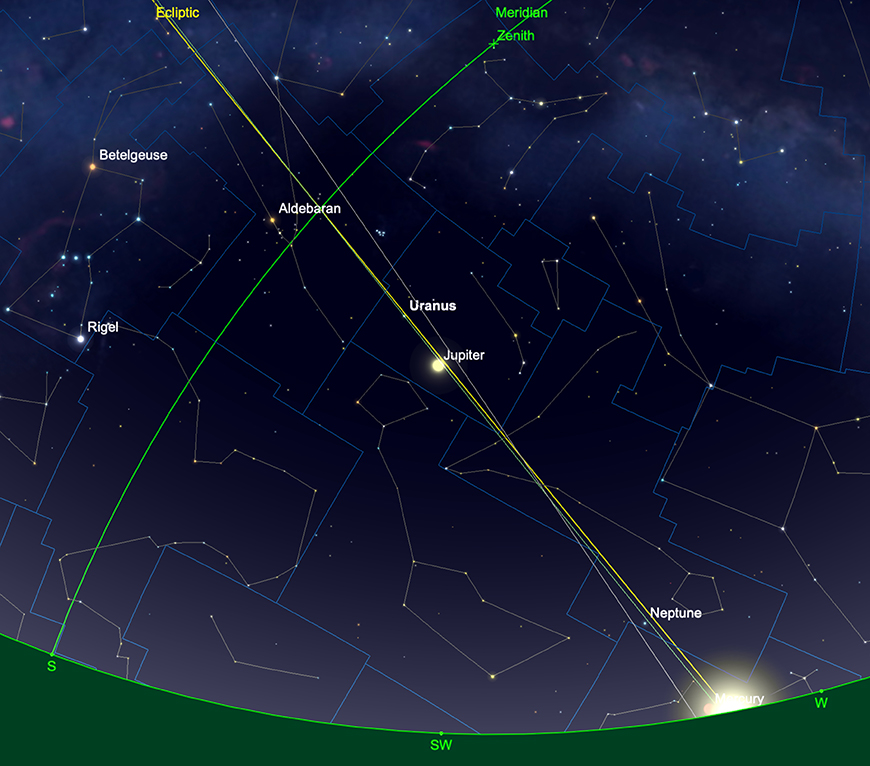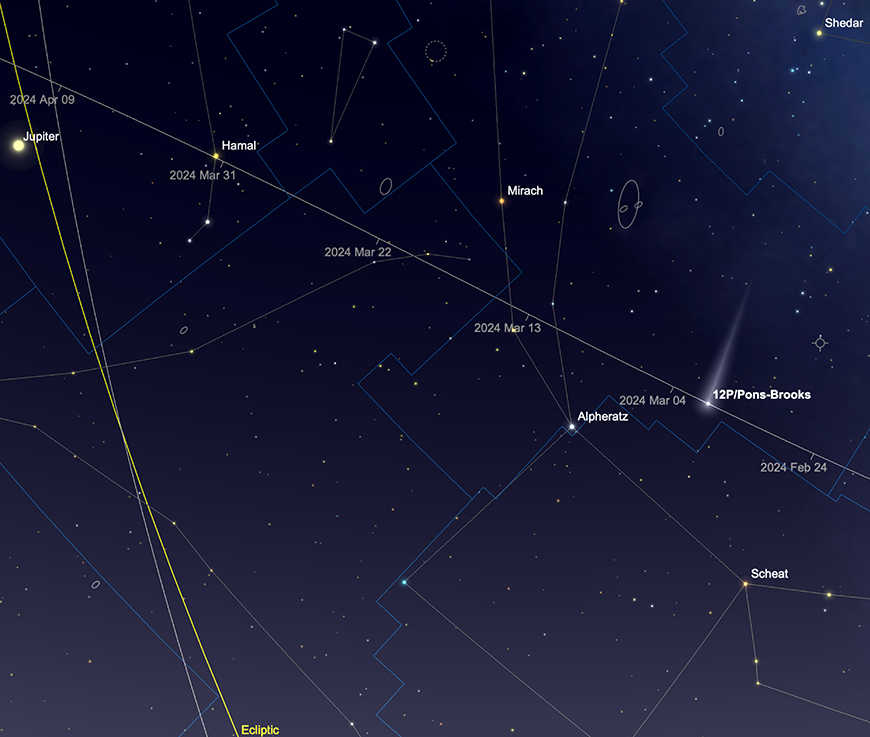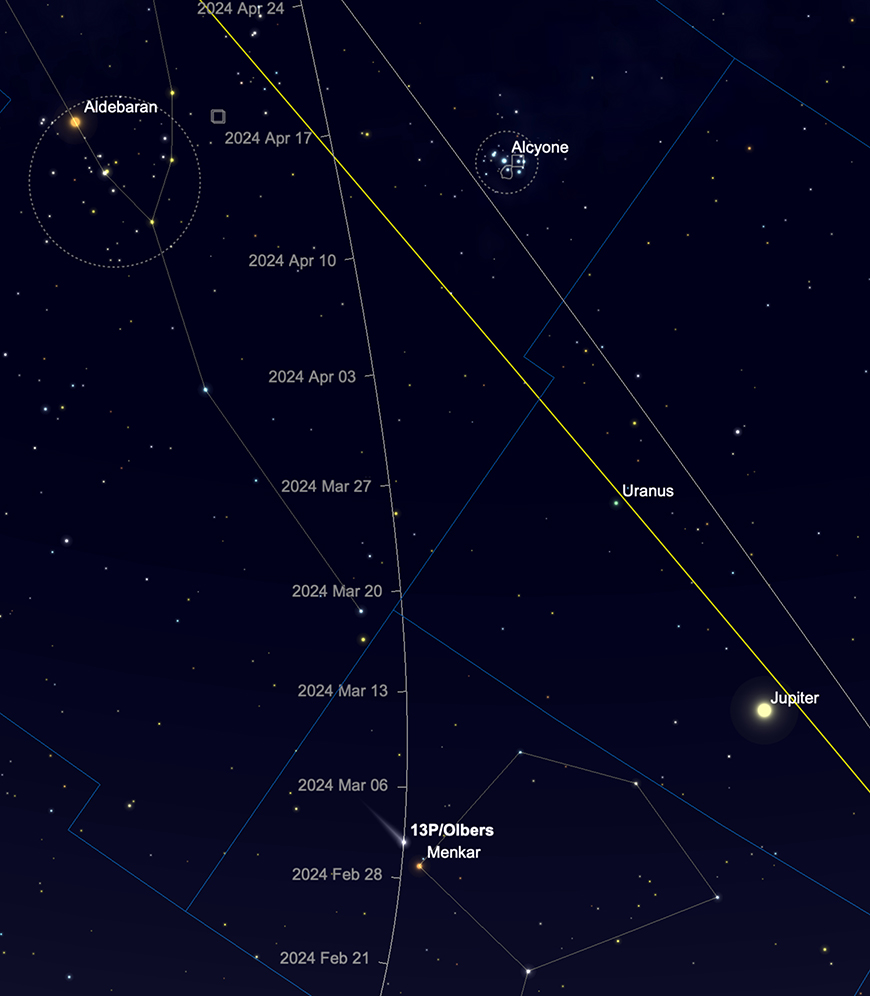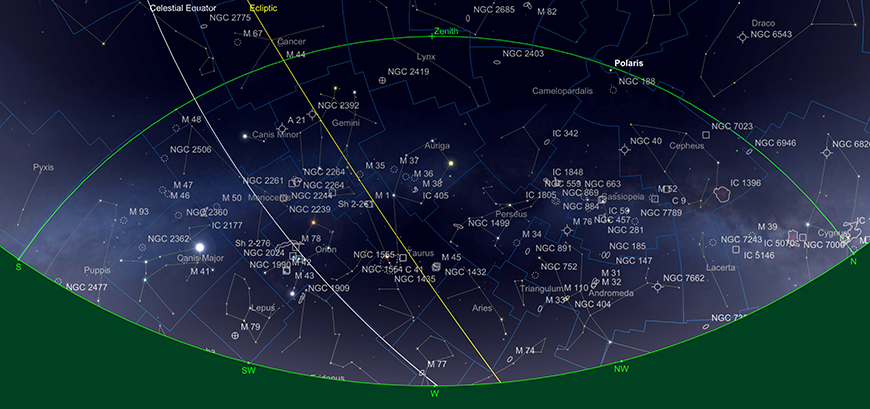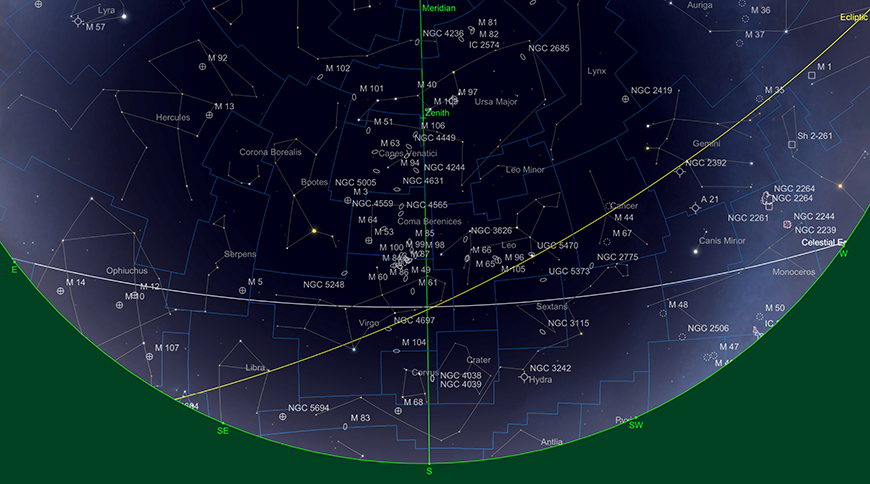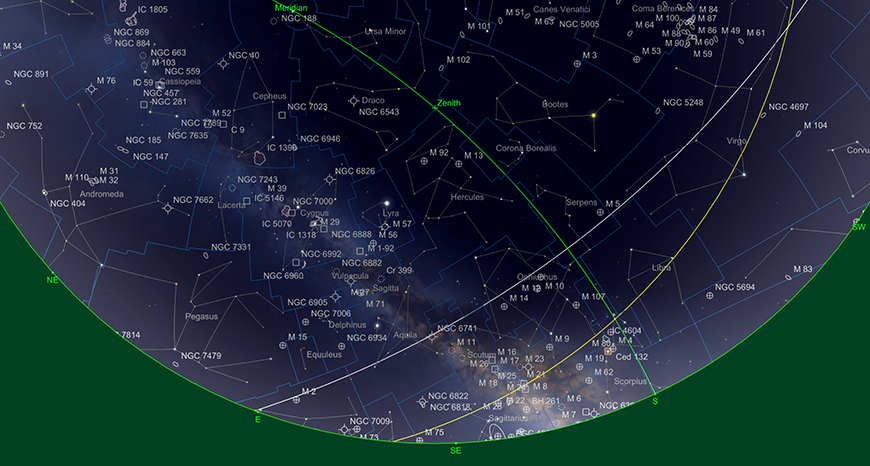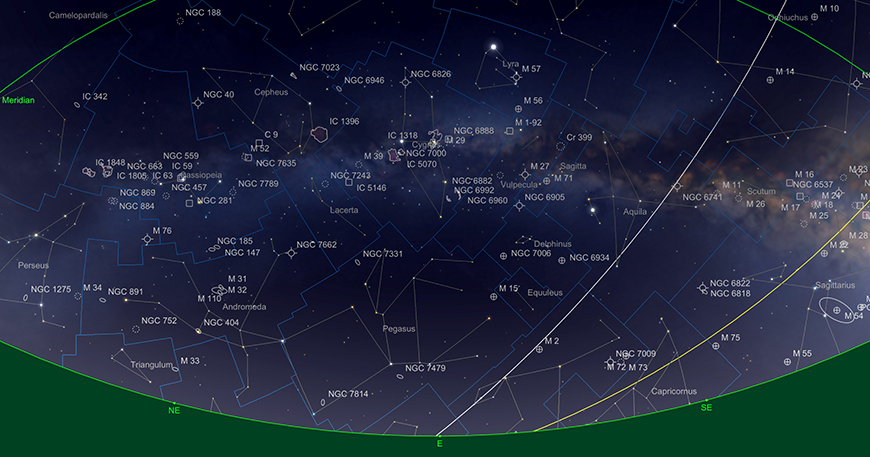Saturn
Saturn is emerging from late February’s superior conjunction and for the first part of the month will be unobservable, being so close to Sun. Rising almost in line with the sun from mid Northern latitude in Aquarius, the ringed planet will remain in a very poor observational position until later in March, when it has attained a reasonable separation from the Sun. However, even by the end of March, Saturn will stand just 5°, above the horizon at sunrise (as observed from 51° north) and will still be a very difficult target to find in the glare of the morning sky. Saturn will end the month separated from the Sun by around 27° and flanked Venus and Mars - though will be far too low in the sky for meaningful telescopic observations, outside the equatorial regions of our planet.
Uranus and Neptune
Of the two outer gas giants, Uranus is definitely the better placed during March. Sitting in the constellation of Aries, Uranus can be found around 8° to the east of the much brighter Jupiter, which serves as a handy waypoint to find the much fainter outer world. Uranus will still be at a very reasonable altitude of just under 41° once astronomical dusk occurs on the evening of the 1st.
Neptune, on the other hand, is separated from the Sun by around 15° in on the Pisces/Aquarius borders, and will be an extremely difficult, if impossible target as the sky will be too bright for observation of the eighth magnitude planet in the early evening. Neptune reaches superior conjunction in March 17th, after which it will re-emerge as a morning target, but will be unobservable for some time after this.
Uranus will remain extremely well placed for evening, observation right up until the end of March and beyond. It is currently the planet in the most northerly part of the ecliptic, favouring observation by those in the northern hemisphere. At +5.8 magnitude, Uranus is technically a naked eye object, but is more likely to be visible in binoculars or small telescopes.
Comets
12P/Pons-Brooks is the only comment of reasonable brightness easily observable during March. It should start the month around 6th to 7th magnitude and will be observable through much of the night. The comet is a resident of Andromeda in early to mid March and will set at around 11:30 pm and rises at just before 3 am the following morning on the 1st/2nd March. As the month progresses, it will drift through northern Pisces, skirting the border with Triangulum and ending the month very close to Alpha Arietis, Hamal - the principal star in Aries. By this point, 12P will have increased its brightness to a predicted 5th magnitude. Although 5th magnitude is technically naked eye, the comet’s brightness will be spread out over a wide area, so will definitely need binoculars and/or a telescope to observe it.
Another periodic comet, 13P/Olbers will be making its way through Cetus and into Taurus during March. This will be much less prominent at around 10th magnitude, though should be relatively straightforward to find in larger binoculars and small telescopes. 13P will continue to brighten after the end of March and should reach 7th magnitude - possibly brighter - in May, June and July.
Lastly, C/2023 A3 (Tsuchinshan-ATLAS) is still showing very reasonable progress. It is 12th-13th magnitude at time of writing, but it now predicted to reach around a minimum magnitude of -0.8 - and could become even more spectacular - when it reaches its peak in September to November of this year. There is still a lot that can happen between now and then, but we remain cautiously optimistic for a very good showing from this comet.
Meteors
There are no major meteor showers, observable in March.
Deep Sky Observation - The Messier Marathon
We take a break from our regular round up of in-depth coverage of observations of the extra-solar system kind, to cover the grand tour-de-horizon that is the Messier Marathon. Many readers will have heard of this challenge (indeed we've covered it before in previous sky guides) - to observe as many, if not all of the 110 deep sky objects on the Messier list in one night's sitting. Around the Vernal or Autumnal Equinoxes is normally the most sensible time attempt the Marathon, as the spread of Messier objects in the sky, the chance of clearer weather and a significant amount of darkness all conspire to give us the best chance of picking off the majority - if not all of the Messier list. This year, the weekends of March Friday 8th, Saturday 9th and Sunday 10th and the following April weekend of the 6th and 7th are closest to New Moon in their respective months, giving many of us the best opportunity to take this challenge on.
It must be noted that the Marathon is not possible everywhere in the world. Charles Messier, making his observations from France in the 18th century, did not have the opportunity to add many of the wonderful deep sky treasures of the southern hemisphere to his list, and a significant amount of Messier objects are circumpolar for those in the northern hemisphere - which put southern hemisphere observers at a distinct disadvantage!
The optimum latitude for attempting the Messier Marathon is about 25 degrees N, but this should not put off those who are further north, or south of this part of the world attempting it. You will simply have to complete the Marathon with what's practical to observe from your particular location.
So, what do you need?
1. A Telescope. While it's possible to observe many of the Messier list in binoculars, the type of magnifications needed to resolve some of the fainter members of the list really do require a telescope to be sure of identification. Naturally, the larger your aperture, the better your chances of positively identifying some of the fainter members of the Messier list and a Goto telescope will help immeasurably - though some observers will regard this as cheating somewhat. However, in regards to a telescope's aperture, it should be noted that Messier himself observed with many telescopes throughout his career, but made many of his discoveries using a refractor of around 3-4 inches / 90-102mm of aperture, or a Gregorian reflecting telescope of around 7.5 inches of aperture. Both instruments would have been roughly equivalent in performance to many general starter's telescopes today, albeit they were used in the 18th century, when skies were generally much darker than they are today.
2. A Dark Observing Site. As eluded to above, dark skies are essential to achieving positive identification of some of the fainter members of the list. The absence of the Moon from proceedings is also extremely helpful, as any additional skyglow caused by our natural satellite will be extremely unhelpful. This makes the New Moon period of the 17th March a more favourable time to observe, but a couple of days either side of this date should be good too, with a thin Crescent phase Moon not adding too much to the illumination of the sky.
3. Clear Horizons. The early evening's window of observing objects in the extreme west of the sky will require a clear westerly horizon in order to have any chance of seeing these targets. For instance, around 7th April, the galaxy M74, one of the most beautiful face on spirals in the sky, but unfortunately the Messier object with the lowest combined surface brightness will only be 11° 18 minutes from the setting Sun, so will be set before Astronomical darkness has been achieved from mid-northern latitudes, making it highly unlikely if not impossible to detect. Likewise, M30 in Capricornus won't have risen very high in the sky by Sunrise, so will be a difficult find in the dawn sky at the end of the night. Likewise the wonderful open clusters M6 and M7 in Scorpius and the Globular clusters M54, M55, M69 and M70 are very low and difficult to detect in the morning sky from mid-northern latitudes.
4. Patience and Tenacity. This is a Marathon and not a sprint! Not everything on the list may be observable in one sitting, but the challenge is to observe as much as you can. Special attention should be paid to pacing yourself, making sure you're properly dark adapted, insulated from the cold of a springtime night and hydrated and fueled as well. If you're not paying attention to all of these criteria, you run the risk of fatigue, which will ultimately make the Marathon a slog - when it's meant to be enjoyable.
When attempting the Messier Marathon at this time of year, we can split it up into roughly four quarters. The first of these are those objects that are in the west of the sky after Sunset, which need to be observed quickly before they set (or become too low to observe in the north). If you use the Milky way as a dividing line, these are all the Messier objects that fall to the West of this point. This section of sky includes some of the brightest and best known of the Messier list: M31, the Andromeda Galaxy and its two attendants M32 and M110; M33 the Triangulum Spiral (which will be a tricky target in the evening at this time of year, due to its low surface brightness); the wonderful Pleiades (M45) and M1, the Crab Nebula in Taurus and of course the Orion Nebula complex, M42 and M43. While these targets are pretty easy to find, special attention should be shown to those potentially difficult objects in the southern reaches of this sector, such as the globular M79 in Lepus, which will be set by just past 9pm from mid-northern latitudes. It is also a good idea to attempt to observe the circumpolar Messier targets in the low NNW, such as the open cluster M39 in Cygnus and the easier, higher up targets in Cassiopeia and Perseus, if possible, though there will be opportunities to observe these later, if this is not practical.
The second quarter of the Marathon is the most populous in terms of extra-galactic Messier objects This area of sky is the swathe east of the Milky Way, which takes in the huge arc of galaxies which runs from the fantastic pairing of M81 and M82 in the northern reaches of Ursa Major, down through multiple galaxies in Canes Venatici, Coma Berenices down into the huge riches of VIrgo and Leo, ending south of the celestial equator with the challenge of M104, the Sombrero Galaxy on the Virgo-Corvus borders. This area takes in just over a third (36) of the Messier List and will take the longest time to work through. Naturally a Goto telescope will help considerably here, as many of the objets in this part of the sky are towards the fainter end of Messier's list and tricky to find and positively identify for the uninitiated. Amongst the profusion of galaxies, there are notable globular clusters in the guise of the magnificent M3 in Canes Venatici and M53 in Coma Berenices, the intriguing Owl Nebula, M97 - the "companion" of the galaxy M108, both of which are found near Merak, Beta Ursae Majoris. There is also the strange M40, which appears to have been catalogued, despite being simply a double star in Ursa Major.
Where the second quarter of the Marathon was largely taken up by galaxies, the third quarter is very much the preserve of nebulae and star clusters - particularly the globulars which orbit the central bulge of the Milky Way. This quarter will have to wait until well after midnight in order to risen high enough for observation and contains the riches of Ophiuchus, Scorpius and Sagittarius - to west of the "Summer" part of the Milky Way, which looks directly towards of galactic centre and the richest area of deep sky objects bounded by our galaxy. In addition to the area, there are also the more northerly targets in Serpens (Caput), Hercules, Lyra and the Western half of Cygnus. This is a really challenging part of the marathon, as many of the targets will be very far south from mid-northern latitudes and atmospheric extinction will play a large part in observations. Highlights in this area include the great globular clusters of M13 and M92 in Hercules, M5 in Serpens, M10, M12, M14 and M07 in Ophiuchus and, if observable, M80 and M4 in Scorpius. However, you may have to revisit the latter two objects later in the night to see them well, if at all.
The last quarter of the Messier Marathon really is a race to see as much as is possible before the Sun begins to rise and Astronomical Dawn begins, which for many mid northern hemisphere latitudes is just after 4am at this time of year. This area of sky includes the eastern side of the "Summer" section of the Milky Way from the eastern side of Sagittarius in the south, up through Sagitta, Vulpecula and the eastern side of Cygnus, on through to the star clusters in Cassiopeia in the north. This area also includes the great globular clusters M15 in Pegasus and M2, below it in Aquarius. This area inevitably includes some of the toughest fainter objects to attempt to see before the dawn breaks - notably the fainter globulars M72 and M75 and the rather disappointing asterism M73, all in Aquarius. These will be extremely tough, if not impossible to see from higher northern latitude before the Sun makes its presence felt. However, this part of the night gives observers in higher northern latitudes the best chance of seeing the great areas of nebulosity in Sagittarius, M8 the Lagoon Nebula, M20 the Triffid Nebula, M17 the Omega Nebula and the Eagle Nebula in neighbouring Serpens at reasonable altitude.
When you consider the possibility of seeing the lion's share of the Messier list in one sitting, it is perhaps wise to consider that it took Messier, aided by the excellent contemporary observer Pierre Mechain and reference to the observations of other earlier telescopic astronomers such as Giovanni Battista Hodierna, over a decade to expand his initial list of 45 objects, published in 1771, to the 102 objects of his final list, which was published in 1781. With reference to Messier's observing notes, this final list was expanded to the 110 objects we know today, by Messier scholars in the 20th century. If it took Messier, a professional astronomer, this long to be sure of his observations, then don't be too disappointed if you can't see all of the Messier list in one night, should you attempt the Marathon. If you do attempt this epic task, we hope the weather is kind to you and however many objects you find, you enjoy it.

 English
English
